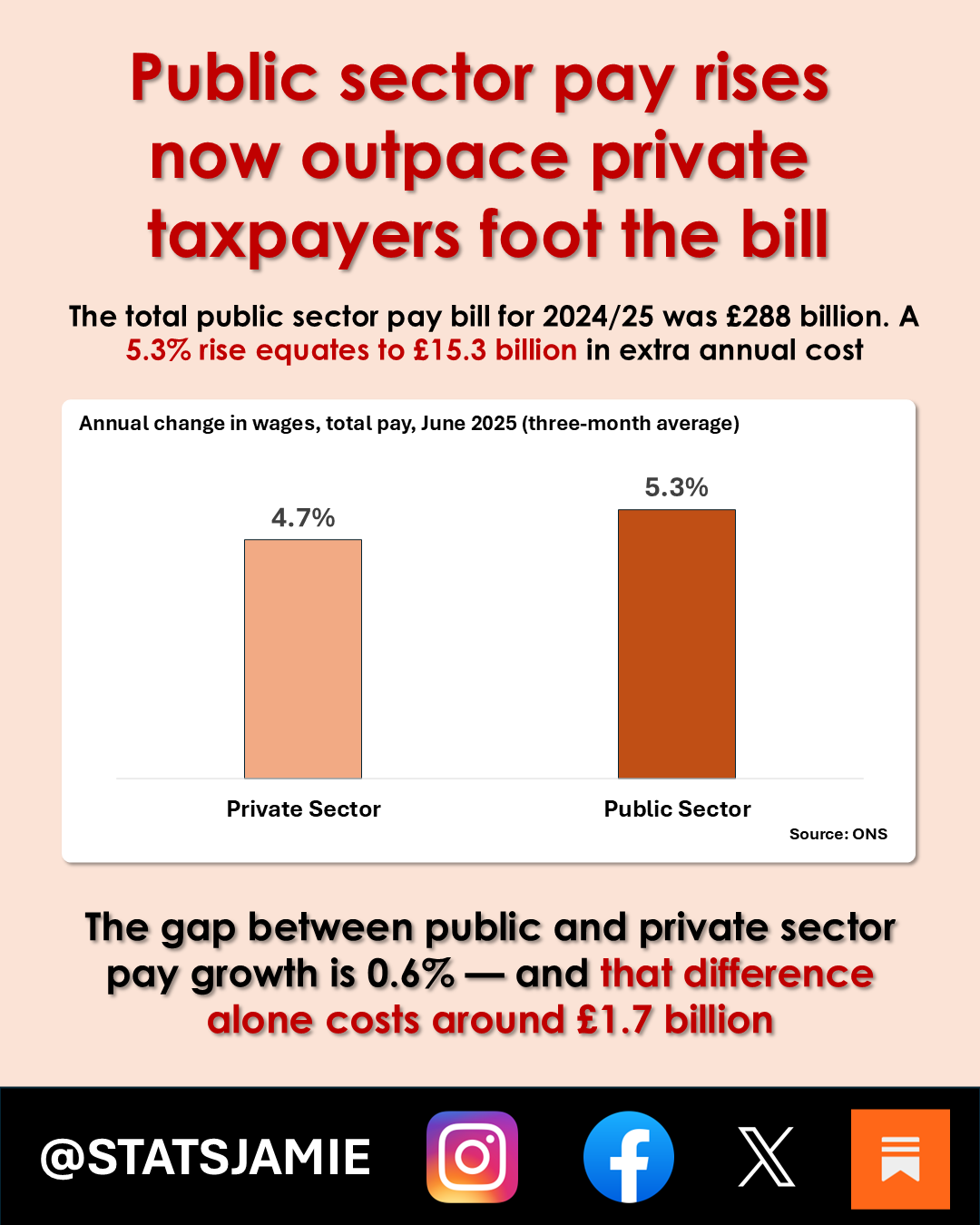Public sector pay rises now outpace private – taxpayers foot the bill
Private pay cools, public wages stay high — and taxpayers face the bill through higher borrowing
Public sector pay is now rising faster than private sector pay. In the latest ONS data, total pay in the public sector rose by 5.3%, compared with 4.7% in the private sector.
Private sector pay growth is cooling, while public wages hold firm. With jobs shrinking in the private economy but rising in taxpayer-funded roles, Labour’s growing state is being bankrolled by higher borrowing — and the taxpayer.
Private Sector Pay: Slowing Under Pressure
At the end of 2024, private sector regular pay was rising at 6.3% year-on-year. That’s now dropped to around 4.7%, according to the latest ONS data.
Why? Inflation is easing. Interest rates remain high. And businesses — especially SMEs — are under pressure from weaker demand, rising costs, and tighter margins.
But there’s another pressure point: tax.
The National Insurance hike that took effect earlier this year is now baked into employer overheads. For many, it’s a jobs tax — and it’s forcing them to think twice about wage rises.
With higher business costs across the board and a flatlining economy, pay growth in the private sector is cooling — and employers are pulling back.
Public Sector Pay: Holding Firm With Labour’s Backing
Public sector pay remains strong — and that’s no accident.
Since entering government, Labour has moved quickly to end public sector pay disputes, making concessions that the previous government resisted. The most high-profile example? Junior doctors.
After years of strike action and stand-offs, Labour agreed a multi-year deal worth over 22% — a major climbdown that sent a clear message: the new government was willing to spend to restore industrial peace.
That deal set the tone. Similar settlements followed across the NHS, teaching, and civil service — pushing up overall wage growth in the public sector, just as private employers were pulling back.
And importantly, many public sector staff receive automatic pay scale progression on top of headline awards — meaning the real increase in take-home pay is often higher than the official figure.
The result? Public pay is holding firm, and in many cases, rising faster than the market.
Where the Jobs Are Going
The shift isn’t just in pay — it’s in employment too.
Since Labour came into office, the payroll jobs picture has turned negative. Between June and July 2025, the UK lost 157,000 payroll jobs.
But look closer, and the picture splits:
Taxpayer-funded job gains:
Health & social work: +74,000
Education: +29,000
Public admin, defence & social security: +27,000
Private sector job losses:
Accommodation & food services: -116,000
Retail, wholesale, motor repairs: -69,000
The trend is clear: the state is hiring, while the private economy — the part that funds everything — is shrinking.
Explore the full breakdown in my post on payroll job trends → Payroll Jobs Keep Falling: Labour’s Jobs Tax is Biting
A Growing State, A Growing Bill
There’s no public sector without a private sector to fund it.
But the direction of travel is stark:
Public sector wages are rising faster than private sector wages
State jobs are growing, while private employers are cutting back
Government borrowing is climbing to cover the cost
And here’s the fiscal reality:
📌 The total public sector pay bill for 2024/25 was £288 billion. A 5.3% rise on that equates to £15.3 billion in extra annual cost.
You can’t deny pay rises across the board — especially after a decade of pressure in frontline services. But the gap between public and private sector pay growth is 0.6% — and that difference alone costs around £1.7 billion.
To put that in context:
It’s more than the Government expected to save by scrapping the winter fuel allowance.
And it’s over three times what it hopes to raise each year from the controversial farming tax announced earlier this summer.
The growing cost of the state isn’t just a budget line — it’s a choice, with trade-offs.
The taxpayer ends up squeezed twice:
Once through a slower private jobs market.
Again through higher taxes or borrowing to fund a growing state.


